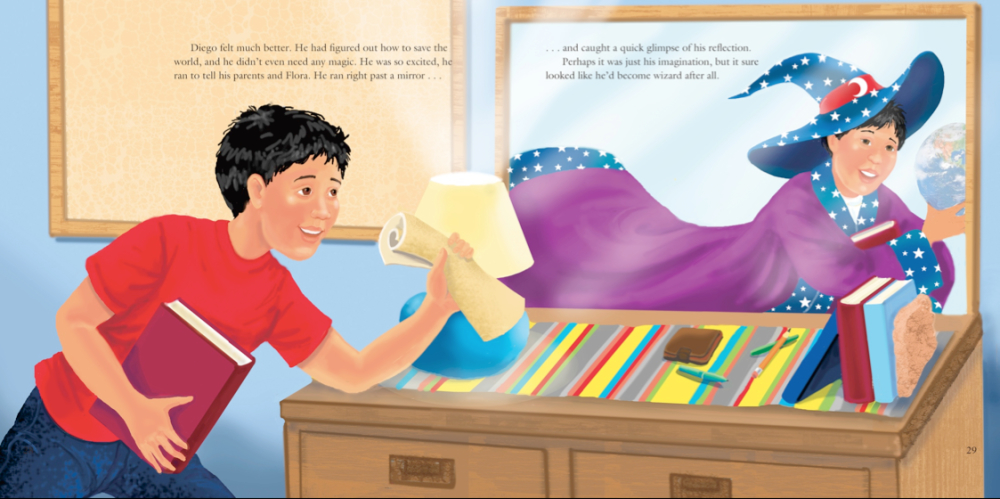Climate Change Education: Hints and Tips for Teaching Kids How to Tell What's Real

At the end of The Wizard Who Saved the World, says author Jeffrey Bennett, we want kids to leave any school discussion of global warming with the belief that they, too, have the power to be a “wizard” who can help us build a better world for all.
Editor’s Note: This is part of our ongoing #IndieVoices series of commentaries and features in the month of March focusing on Climate Change. Read the introduction to the series here.
Human history becomes more and more a race between education and catastrophe. — H.G. Wells, The Outline of History, 1920

The topic of global warming is clearly relevant to the H.G. Wells quotation above, because it is widely misunderstood even as it represents a serious threat to the future of our civilization. As a scientist, educator, and author of books focusing on global warming both for grownups (A Global Warming Primer) and for children (The Wizard Who Saved the World), I’ll offer a few hints about how to educate successfully while avoiding the pitfalls that often arise with this topic.
Hint 1: Keep the scientific focus on ‘how we know’
Science is often presented as a collection of facts, but we can’t expect students or the public to accept facts without explaining how we know them. I like to present the basic scientific case with what I call “global warming 1-2-3,” and it goes like this:
Fact: Carbon dioxide is a greenhouse gas, by which we mean a gas that traps heat and makes a planet (like Earth or Venus) warmer than it would be otherwise.
How we know it’s a fact: (1) The greenhouse effect has been observed and measured in the laboratory for more than 150 years; (2) We can explain planetary temperatures successfully only when we account for the greenhouse effect.
Fact: Human activity, especially the use of fossil fuels—by which we mean coal, oil, and gas, all of which release carbon dioxide when burned—is adding significantly more of this heat-trapping gas to Earth’s atmosphere.
How we know it’s a fact: We have directly measured the rapidly rising concentration of atmospheric carbon dioxide, and chemical analysis shows that this added carbon dioxide is coming primarily from fossil fuels.
Inevitable Conclusion: We should expect the rising carbon dioxide concentration to warm our planet, with the warming becoming more severe as we add more carbon dioxide.
Once students and the public understand this 1-2-3 science and the evidence behind it, they can see why the basic idea of global warming is not subject to any dispute at all. Indeed, you’ll notice this fact in the media debate: While you’ll sometimes hear scientists debating intricacies of climate models or satellite measurements, you’ll never hear a debate over the 1-2-3 science. To put it another way: No one with any scientific training disputes the fact that global warming will occur; the debate is only over how quickly it will occur and how much of a threat it represents.
Hint 2: Make the science meaningful
Science education often focuses strictly on scientific concepts, but not everyone finds the science inherently appealing. If we want to get all of our students to learn science, we need a broader approach that makes the science meaningful. I recommend a three-pronged focus on “education, perspective, and inspiration” for all science teaching, and here I’ll give the example of how it applies to global warming:
Education. The education piece is the science content. The specific content will vary with grade level, but the general focus should be on the idea that global warming is an easily understood scientific idea, backed by strong evidence that anyone can investigate for themselves.
Perspective. The science of global warming can shift our perspective in many ways, but perhaps the most significant is in the way it changes our perspective on our relationship with our planet. The present generation is the first generation in the history of the human race that has ever had the ability to cause large-scale changes to the global environment. This means that while past generations could in some sense think of themselves as being at the mercy of “mother nature,” we now control our own climate destiny. The choices we make today will determine the type of environment in which our descendants will live for centuries or millennia to come.
Inspiration. Global warming is scary, but rather than leaving students feeling overwhelmed and worried, we want to use the topic to inspire them in positive ways. For example, we should always show them that global warming is a solvable problem, and that the potential solutions could mean new ideas and technologies that would give us the kind of future that children like to dream about. In other words, as you’ll see at the end of The Wizard Who Saved the World (illustration above), we want kids to leave any school discussion of global warming with the belief that they, too, have the power to be a “wizard” who can help us build a better world for all.
Hint 3: Teach across disciplines
Global warming is based in science, but it affects virtually everything. Therefore, it should be taught across the curriculum in appropriate contexts. For example, the graphs and data of global warming can be presented and discussed in math; the impacts of global warming can be discussed in social science; and the policy issues of global warming can be discussed in terms of government and politics.
The inspiration piece above can be used to spur thought about future career options, which can be turned into such things as art or music activities for younger children and career discussions for middle and high school kids. If you are a teacher, use your creativity to find ways to integrate teaching about global warming into all of your subjects.
Hint 4: Adapt to grade and course level
My final hint concerns the fact that this topic is so important that we should be revisiting it with students every year, with increasing levels of sophistication as students get older. A few broad suggestions by grade level:
Grades K-2: At this age, we cannot expect kids to understand the scientific arguments, so instead we should focus on things like “what you can do to help,” thereby inspiring kids to think about how this societal problem can translate to opportunities for their own futures.
Grades 3-5: Children in this age group are beginning to build critical thinking capabilities, so this is the ideal time to introduce the 1-2-3 science above; they are also ready to begin learning about how to read graphs and evaluate evidence.
Grades 6-8: We can begin to differentiate by course in middle school. For example, social science classes should include discussion of the sociological and international impacts of global warming, while math and science classes can begin to look more deeply at data collection and analysis.
High school: Students are ready for much more depth. For example, learning to critically evaluate evidence and arguments, learning the principles of mathematical modeling in general and climate modeling in particular, and discussing pros and cons of various potential solutions to the problem of global warming.
In closing, please keep in mind that the above set of hints is a very short list based on my personal views about teaching. I hope it will be of use to some of you, but be sure to consult other sources as well as you go out to teach children about climate science and global warming.

Jeffrey Bennett, a winner of the American Institute of Physics Science Communication Award, is the author of numerous books for college students, children, and the public, including seven books that have been launched into space. Learn more about his books at Big Kid Science.
JEFFREY BENNETT
